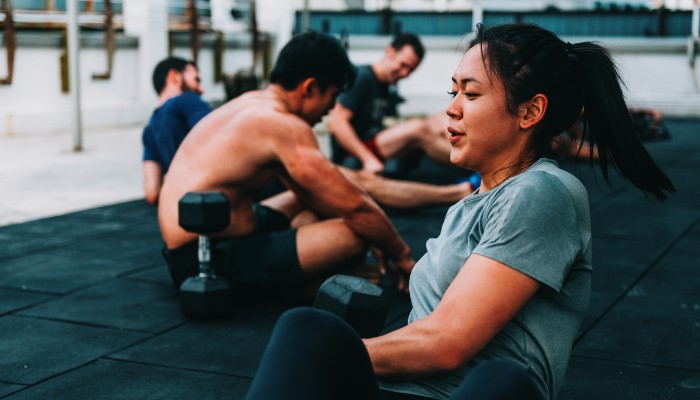How To Prevent Golf Elbow & Other Common Golf Injuries
The game of golf is one that challenges not just the intellect and strategy but also the physical stamina and precision of its players. Mastery requires a blend of concentration, skill, and a well-conditioned body to execute the delicate yet powerful strokes.
Despite its tranquil facade, golf is not a sport devoid of physical exertion. It's not just about the artful tap that sends the ball cruising towards the green; it's also about the calculated swing, the tensed muscles, and the cleverly aligned stance.
And while it may not involve high-speed collisions or the intense physical contact seen in sports like rugby or football, golf carries its own unique set of risks. From strains in your back to the notorious golf elbow, the game can be more physically demanding than it first appears, especially if approached without the right preparation or technique.
But fear not, dear golfer. With the right knowledge of prevention, timely treatment, and a trusty insurance shield to cover those unforeseen fairway follies, the joy of the sport need not be compromised. So, read on, and let's keep the bogeys at bay while we conquer the greens.
1. Back injuries
A golf swing may seem like a simple action to the untrained eye, but it's a complex ballet of biomechanics. It involves a powerful, twisting motion that puts stress on the muscles, joints, and discs in your back.
Think about the swing – it's like a coiled spring that unwinds with ferocious intensity. Over time, this repetitive strain can make its presence felt in the form of a nagging ache or sharp pain in your back, eventually leading to serious discomfort or even chronic conditions like herniated discs if not addressed properly.
Prevention tips: Focus on your golf swing. An incorrect golf swing can place undue stress on your back. Consider taking professional lessons to learn how to swing properly and to perfect your swing. Also, include core-strengthening exercises in your workout routine to increase your back’s strength and flexibility. A stiff back is more prone to injury, so include stretches and flexibility exercises in your routine.
2. Elbow injuries
In golf, a certain malady known as ‘golf elbow’ is infamous among players. Don't let the name deceive you – it's not a medal of honour but an uncomfortable condition that you would rather avoid.
Golf elbow is a type of tendinitis, a condition marked by pain and inflammation in the tendons that connect the forearm muscles to the inside of the elbow. This affliction usually crops up due to the overuse and strain of these muscles during a golf swing, especially when repeatedly performed with improper technique.
Prevention tips: Use the correct golf grips and golf clubs. The wrong equipment can place extra strain on your elbow. Also, by incorporating forearm strengthening exercises, like wrist curls and resistance band workouts, into your fitness routine, you enhance these muscles' ability to handle golf swing stress, thus reducing tendon strain.
3. Knee injuries
Golf is indeed a serene sport, but beneath this serene exterior lies a significant physical challenge, particularly for the knees. Every time you take a swing, your knees are engaged in a subtle dance of rotation and weight-bearing, acting as pivotal anchors for the dynamic movement of the rest of your body.
Over time, this rotational stress, coupled with the walking typically involved in a round of golf, can manifest as knee injuries. These might present as pain, stiffness, or inflammation, sometimes escalating into more serious conditions such as meniscus tears or ligament damage.
Prevention tips: It's essential to cultivate a swing that evenly distributes the force throughout your body to decrease strain on your knee. Strengthening exercises targeting your quadriceps and hamstrings can also help support your knees. Squats, lunges, and leg curls are a few exercises that can help strengthen these muscle groups.
4. Rotator cuff injuries
The shoulder is a marvel of engineering – especially the rotator cuff, a group of muscles and tendons that stabilise the shoulder joint. These unsung heroes work behind the scenes, orchestrating every swing you take on the golf course.
However, the repetitive, powerful swinging motion involved in golf can take a toll on your rotator cuff, leading to strains, tears, or inflammation, collectively known as rotator cuff injuries.
Rotator cuff injuries can be quite a menace, causing pain, weakness, and limited motion in the shoulder. A golf swing with a compromised shoulder is far from ideal, affecting both the power and accuracy of your shot. So, how do we keep these crucial muscles in top shape?
Prevention tips: Include shoulder-strengthening exercises in your fitness routine to bolster your rotator cuff muscles. Exercises such as internal and external rotations with a resistance band, shoulder press, and lateral raises are particularly beneficial for the rotator cuff.
Power in a golf swing comes from technique and timing rather than sheer force. An overpowered, jerky swing can place unnecessary strain on your rotator cuff, increasing the risk of injury. Strive for a smooth, controlled golf swing that flows through the body.
5. Hand injuries (hand, finger & wrist)
We've all heard the saying, "It's all in the hands," and in golf, this statement rings particularly true. Your hands, fingers, and wrists are your primary points of contact with the golf club, making them key players in your golf swing. They guide the club, maintain its grip, and absorb the impact of the club hitting the ball.
However, this vital role also exposes your hands, fingers, and wrists to potential injuries. These injuries can range from minor inconveniences, such as blisters and calluses, to more debilitating conditions like tendonitis, sprains, or fractures. Left unchecked, these issues can turn your love for golf into a painful affair and significantly affect your game.
Prevention tips: Regularly performing hand and wrist stretches can prevent these injuries. Also, using the right golf equipment, including clubs and gloves, can reduce strain on your hands.
6. Neck injuries
A golf swing is not just a test of your strength, but also a symphony of synchronisation, and at the centre of this choreography is your neck. From the moment you fix your gaze on the ball to the final follow-through of your swing, your neck is in a constant state of rotation.
This rotational movement, combined with the need to maintain a steady focus on the ball, places a significant amount of stress on your neck. Over time, this strain can lead to discomfort, stiffness, or more severe neck injuries.
Prevention tips: Regular neck exercises and stretches can increase your neck’s flexibility and strength. Remember to warm up before your golf round to prepare your neck muscles.
7. Foot & ankle injuries
While the hands may guide the swing and the body might power it, it's your feet that keep you grounded during a golf game. The feet and ankles form the foundation of your golf stance and bear the weight of your body during a swing. This role, however, also leaves them prone to injury from improper weight distribution or traversing the undulating terrain of a golf course.
Injuries to the feet and ankles can be as minor as blisters or as serious as sprains, strains, or fractures. Regardless of severity, any injury to these areas can negatively affect your swing, stability, and mobility on the course, making prevention crucial.
Prevention tips: Wearing the right footwear is vital. Opt for golf shoes that provide good support and fit properly. Also, incorporate foot and ankle-strengthening exercises into your routine.
8. Hip injuries
In the symphony of a golf swing, your hips are the maestro – conducting the power from your core and legs through to your upper body and, eventually, the club. They rotate, tilt, and flex in a sequence that is as dynamic as it is vital to a successful shot.
However, the force and rotation exerted on the hips during this process can lead to hip injuries, ranging from strains to more severe conditions like bursitis or hip impingement.
These injuries can cause significant discomfort, affect your swing, and potentially keep you off the green. Hence, adopting preventive measures is critical for any golfer who wants to maintain their form and enjoy the game injury-free.
Prevention tips: Incorporate hip-strengthening exercises into your regimen. Improve your swing technique to ensure a proper transfer of power from your body to the golf ball, reducing the risk of hip injuries.
Importance of personal accident insurance
Prevention is better than cure, but accidents can still happen. Therefore, having the right insurance becomes crucial. A comprehensive personal accident insurance plan like Income’s PA Fitness Protect can be a safety net when you need it most.
PA Fitness Protect provides accident protection for fitness fanatics with the following benefits:
- Enjoy 2X coverage for medical expenses due to accidental tears, dislocations and fractures which most health insurance plans do not cover1.
- Up to $1,000,000 third party liability coverage per accident2.
- Up to $2,000 coverage per policy year3 for accidental damage to rented sports equipment.
- Add-on coverage for your own sports equipment like golf clubs
- Reimbursement of up to $5,000 unused activity fees per policy year4 if you are unable to attend due to sickness or injury
Having insurance ensures that you can focus on what truly matters – enjoying the beautiful game of golf. Follow the prevention strategies, ensure your golf swing is in top form, choose the right golf equipment, and consider a personal accident insurance plan. That way, you can keep teeing off in comfort and confidence, aiming for that ever-elusive hole-in-one!
1 ActiveProtect covers medical expenses due to accidents during the sport or exercise. Most health insurance plans do not cover outpatient medical treatment without hospitalisation. Policy terms, conditions and exclusions apply.
2 This benefit limit is applicable under Prestige Plan coverage.
3 We will pay the amount of compensation the insured person is required to pay for accidentally damaging his/her rented equipment.
4 This benefit limit is applicable under Prestige Plan coverage. We will reimburse the unused non-refundable activity fee incurred if the insured person suffers an injury or sickness and is given hospitalisation leave or is required to stay as an inpatient in the hospital during the period of the activity for which he/she has paid an activity fee. We will not pay if the claim for activity fees is less than $50. Please refer to the policy conditions for more details.
This article is meant purely for informational purposes and should not be relied upon as financial advice. The precise terms, conditions and exclusions of any Income Insurance products mentioned are specified in their respective policy contracts. For customised advice to suit your specific needs, consult an Income Insurance advisor. This advertisement has not been reviewed by the Monetary Authority of Singapore.
These policies are protected under the Policy Owners’ Protection Scheme which is administered by the Singapore Deposit Insurance Corporation (SDIC). Coverage for your policy is automatic and no further action is required from you. For more information on the types of benefits that are covered under the scheme as well as the limits of coverage, where applicable, please contact Income Insurance or visit the GIA/LIA or SDIC websites (www.gia.org.sg or www.lia.org.sg or www.sdic.org. sg).







